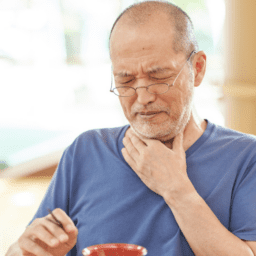Not all Parkinson’s motor symptoms are as well–known and visible as tremor, stiffness, slowness, and postural instability. Micrographia is less well-known but very frustrating if you experience it. In this post, we’ll look at the causes and impacts of micrographia, as well as ways to manage it.
What is micrographia?
Micrographia is cramped, small handwriting that approximately 50% of people with Parkinson’s exhibit. When it refers to consistently small and abnormally small handwriting, it is called constant micrographia. Handwriting that becomes progressively smaller as you write is called progressive micrographia.
Here’s another way to think about it. Akinesia and bradykinesia refer to the reduction of movement, slowness of movement, and sometimes even complete lack of movement caused by Parkinson’s. Hypokinesia refers to a loss of momentum or force in movement that can come with Parkinson’s, usually connected with akinesia, bradykinesia, or both. Micrographia is thought to be some combination of akinesia and hypokinesia.
What causes micrographia?
Like other Parkinson’s motor symptoms, micrographia results from damage to the basal ganglia, the part of the brain responsible for motor control. The neurodegeneration of dopaminergic neurons and loss of dopamine depresses the nigrostriatal pathway and impairs motor activity. Among other impacts, this impairment can lead to slow movement, tremor, and dystonia (intense muscle contractions) in your hands and/or fingers, all of which can cause micrographia.
What strategies can help you manage micrographia?
Handwriting Training
The first strategy is regular practice. Just as practicing your penmanship in elementary school helped you improve your handwriting, taking time each day to work on your writing now can improve your physical ability to write.

What’s more, regular training may even alter your neural pathways. A 2018 study that investigated cortical network changes in 42 people with Parkinson’s found that six weeks of intensive writing training modulated neural connectivity between task-related cortical regions in people with Parkinson’s. The study participants who received prolonged and intensive writing training displayed significant connectivity changes within the handwriting network. The connectivity targeting the brain’s supplementary motor area (SMA), a part of the cerebral cortex that helps control movement, increased through the influence of an enhanced left-hemispheric visuo-parietal coupling. Because the SMA is a major “output region” of the basal ganglia, poor functioning of the SMA and basal ganglia can impact voluntary, automatic movements like handwriting. Strengthening the coupling between two areas, therefore, may result not only in better handwriting but also in improved motor learning. (In short, the six-week intensive handwriting training showed evidence of neuroplasticity in people with Parkinson’s. This means that practicing their handwriting helped participants’ brains discover new nerve cell connections in the areas of the brain responsible for vision and movement learning.)
Occupational Therapy
An occupational therapist (OT) can help you manage micrographia in several ways. They can evaluate your handwriting technique and suggest tools and exercises to improve it. Fred Schott, who was diagnosed with Parkinson’s in 2017 and worked with an OT on exercises to reawaken his fine motor skills said the handwriting practice and third-grade cursive worksheets his OT gave him were a lot harder than he remembered. (But they worked; his scores in this area improved significantly after the therapy.)
Assistive Tools and Devices
There are many tools and gadgets that can help you write more easily while also strengthening your handwriting. Pen grips, which are round or triangular rubber or foam cylinders, can make it easier to hold a pencil or pen. Special pens that are larger than typical pens are also easier to grip and make writing less difficult. Weighted pens can also help and have been shown in some studies to be beneficial for people who experience tremors in their hands. You can also explore weighted gloves to help minimize tremor. When it comes to paper, choose lined so you can work on keeping all letters the same size.
Adjustments to Writing Style
Writing in print rather than cursive can help improve micrographia because it forces you to slow down and make a deliberate effort to form each letter. This can make your writing more legible.
Hand-strengthening Exercises
Writing requires hand strength. To improve yours, spend a few minutes several times a day doing simple stretches with your hands, like opening and closing your fingers or creating a fist and squeezing your hands. Writing also requires fine motor skills, which you can improve through regular practice and creative projects that involve cutting, coloring, sewing, and weaving.
General Motor Symptom Management
As with the management of other motor symptoms, micrographia can also be minimized through healthy lifestyle choices, including regular exercise, taking your medications on schedule, getting enough sleep, and practicing self-care.
Take Action Today
Ready to get started with some handwriting practice? Check out the Parkinson’s Cards to Heroes program, a community-based program centered around handwritten letters from people living with Parkinson’s. Download the free WriteMACRO app developed by Creative Neurology and practice your handwriting. Write a note to a friend. Take time to carefully write down your grocery list, focusing on keeping all letters the same size. Write out the lyrics to your favorite song or the lines of your favorite poem. Remember, practice is key! Build handwriting exercises into your daily routine and watch your handwriting improve.
Learn More about Micrographia
Micrografía: 5 Preguntas y Respuestas Comunes
Training for Micrographia Alters Neural Connectivity in Parkinson’s
Micrographia, Much Beyond the Writer’s Hand

















